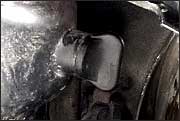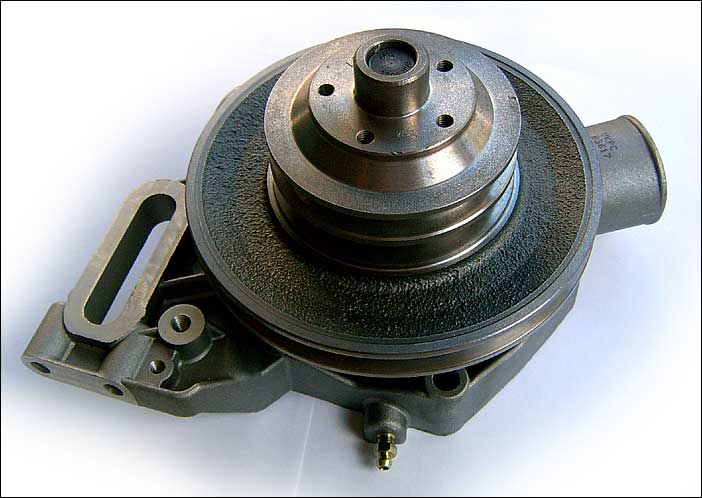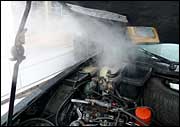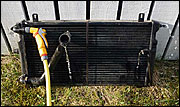|
|
Cooling
Cooling of the engine is mainly carried out by the coolant. In addition, the oil will contribute a little.
|
|
|
|
|
The coolant keeps the engine temperature stable, and adds heat to the register (heater).
It must also prevent rust and regrowth, as well as withstand frost and have a high boiling point.
The water pump keeps the liquid in circulation.
You buy the coolant as a concentrate which you mix with clean (preferably sterile) water. (Do not expose coolant concentrate to frost.)
|
|
|
|
|
- Set the heater to full heat if you have an older CX.
- Protect the alternator with plastic.
- Unscrew the lid of the expansion tank and loosen the air nipples.
- Drain the coolant (the tiny hose on the radiator).
- Replace worn rubber hoses and tighten all hose clamps.
- Slowly drain new coolant into the expansion tank.
- Close the air nipples when coolant starts to spray out.
- Fill the expansion tank to the brim with coolant and screw the lid on.
- Remove the plastic on the alternator.
- Start the engine and let it run at 2000 rpm until the cooling fans start.
- Wait 15 minutes and carefully unscrew the lid of the expansion tank.
- Top up coolant until the level is approx. two cm above the red marker in the tank.
|
|
|
NB!
Never unscrew the lid of the expansion tank while the cooling fans are running!!!
|
|
|
Bleeding
 Air nipple. Air nipple.
Check that the small hole at the bottom of the air nipple is not blocked: if so, use a needle to open it again.
|
|
|
Bleeding the cooling system means getting rid of air pockets. The only place there should be air is in the expansion tank.
There is an air nipple on the water pump, and one on the engine. As well as a ventilation screw up on the right side of the
radiator (you unscrew it with your fingers: be careful not to lose the small gasket if you unscrew it completely).
After you have filled in coolant, you must open the air nipples so that all air can escape. The lid of the expansion tank
must be open while bleeding. Then start the engine and wait for it to warm up and bleed the radiator (gloves and goggles).
The air nipples can be quite stuck, and it is easy to damage them if you use a spanner or similar.
Instead, use a wisegrip pliers that you fasten in an upright position. Tighten the pliers as much as
you can, take a firm grip with both hands, and twist gently. (If you try to attach the pliers sideways,
you may have trouble getting it attached, and you will also put so much force on it that you risk breaking the air nipple.)
|
|

Lufteskruen på radiatoren.
|
|
|
Boiling
Never unscrew the lid of the expansion tank while the cooling fans are running!!!
|
|
If the warning light starts flashing, reduce your speed. Feel free to put the heater on full
(but not up to the windscreen). Do you have coolant or water with you in the car? If not, you
must stop at the first petrol station, grocery store, kiosk etc. Or first stream or river.
If the coolant starts to boil (the warning light is on), stop as soon as possible and let the engine idle.
Open the hood, but do not unscrew the cap from the expansion tank. After a while, switch off the engine,
and after 5 - 10 minutes you can unscrew the lid of the expansion tank. Unscrew the cap very carefully, be
careful not to get splashes in your eyes! Top up with coolant (which you naturally always have with you in
the car!), or clean water if you have nothing else. You also have to loosen the air nipples and let air out
(you do always have an 8mm spanner or wisegrip pliers with you, right?).
|
|
If the water temperature warning light flashes, you need to slow down. If it starts to light up steadily, you must stop as soon as possible.
|
|
|
|
If you want to clean the cooling system, add radiator cleaner (some use washing-up liquid).
After the cure has ended, you must drain as much of the coolant as possible, and flush through with the garden hose:
- Register: Remove the spare wheel, disconnect one hose that goes into the torpedo wall, set the heater to full heat, and flush both directions.
- The radiator: Disconnect both of the two coarse hoses that go into the radiator, and flush through both directions.
Open the air screw and see that water also comes out there.
Fill in new coolant (remember to bleed!). Check the level after the first drive.
|
|
|
|
|
Start the engine, step on the gas and see if coolant sprays out anywhere.
If you find no visible leakage, top up with radiator seal (some use cinnamon).
|
|
|
If the coolant decreases and the oil level rises, and there is a gray-white coating on the
underside of the oil filler cap, you probably need to replace the head gasket.
|
|
|
|
You have one or two cooling fans in front of the radiator.
To check if they work, let the car idle. When the temperature approaches 90°C, they should start at reduced speed,
and 4-5 degrees warmer at full speed. If they do not start, the thermostat for the fans (on the left side of the radiator)
is probably out of order, or there is a bad electrical connection.
|
|
|
You can start the fans manually by shorting the wires that go into the thermostat. Use a short cable with a flat plug at each end.
|
|


|



 Air nipple.
Air nipple.





